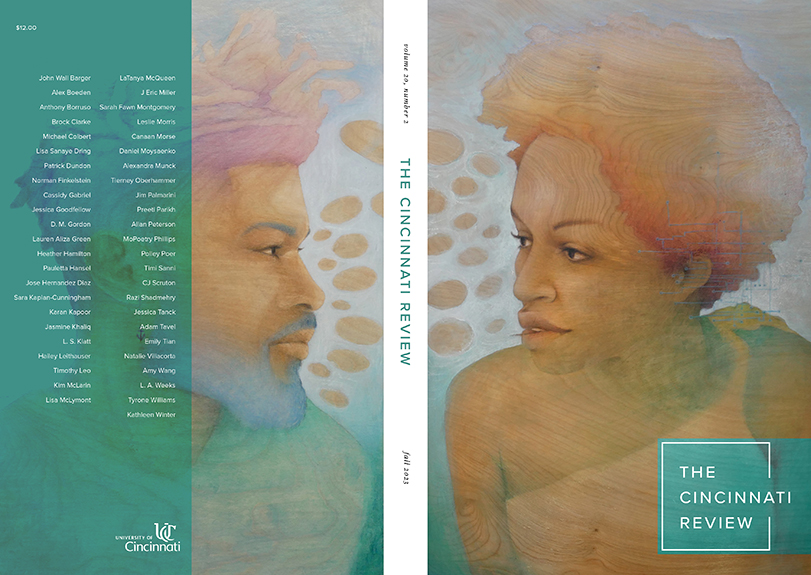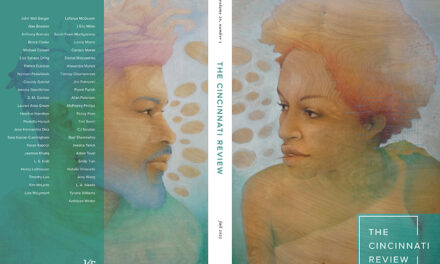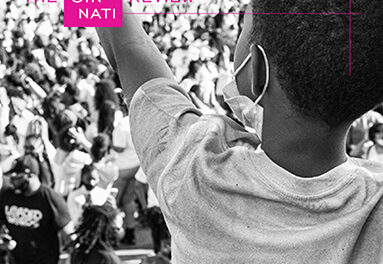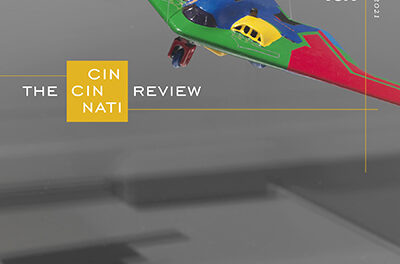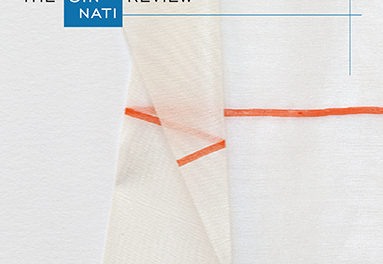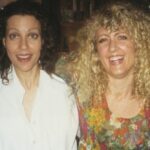In Issue 20.2, one of our twentieth-anniversary issues, we present a special feature on where writing lives in Cincinnati. We reached out to six writers who are current or former residents of the city,giving them the following prompt:
We’ve been thinking about Cincinnati as the site of intersections: of North and South, with the subversive crossing between them by the Underground Railroad; of the geography shaped by an advancing and then retreating glacier, the Ohio River, and the hills; of the Indigenous Algonquian speaking tribes, including the Delaware, Miami, and Shawnee tribes, whose land was taken by white settlers as it became known as Losantiville in 1888. We’re interested, also, in thinking about how the diverse strands of our literary community intersect (or not) here in Cincinnati. Though our various groups focused on creative writing have sometimes felt like separate silos, the Cincinnati Poet Laureate position, the Cincinnati and Hamilton County Public Library writer-in-residence program, and other initiatives like it are breaking down those divisions at times. What is the story of Cincinnati and its literature(s), from your point of view? Where does writing “live” here?
We’re pleased to share here Tyrone Williams’s contribution to the conversation. (Read the entire feature here.)
By the time this issue of The Cincinnati Review appears, it will have been forty years since I left my hometown, Detroit. And until January 2023, all those years were spent in Cincinnati, teaching at Xavier University. I moved to the Queen City of the Midwest in August 1983. Soon after, I received that dreaded “Dear John” letter from my Detroit-based girlfriend, effectively unmooring me from one of my foundations in the Motor City. I began to seek out, as a kind of distraction, whatever literary scenes there were in this new and unfamiliar city in southern Ohio, a city I knew only because when I was a kid, we’d often passed through it—without stopping—on our way to Alabama to visit our relatives.
One place I found was the poetry reading series Upstairs at Grammer’s in Over-the-Rhine, where I first heard some of Cincinnati’s best-known poets—Ralph La Charity, Richard Hague, etc.—and which later migrated over to Arnold’s Bar & Grill. Yet that series, along with a few others, seemed to me fairly narrow in the type of readers and poetry it showcased (La Charity’s tremulous, oracular recitations being the exception), emphasizing Midwestern-Southern sentiments within the formal structures of traditional narrative and lyric poetics. And though, as a Black instructor new to the area, I’d attempted to broaden my own local contacts by writing a brief letter to the African American Studies program at the University of Cincinnati (I never got a response), I had, as it happened, my own narrow perspective on the poetry scene in the city.
So, having realized that “Midwestern” and “Southern” were too general and abstract as categories to capture what I was actually seeing and hearing, I wiped the slate clean and went out exploring once again. I started attending some of the concerts and readings at Southgate House in Covington, Kentucky, where I heard the late (and underrated) Michelle Boisseau, and a little later, York Street Café in Newport, Kentucky. However, when venues like Mockbee (Brighton), Publico (Over-the-Rhine), and especially Chase Public in Northside opened up, my faith and hope were renewed. Here were reading series with a little more edge to them, fiercely anti-academic and adventurous. Yet these new series still seemed to attract their own homogenous audiences—younger than the Arnold’s/Grammer’s/York Street crowd but just as white, at least to my eyes. Some drifted in from the Art Academy; others were the protégés of the new and young creative writing faculty at Miami University, cris cheek and Cathy Wagner. Both not only brought a spirit of adventure to the writing program at Miami but insisted on creating varied writing communities in and around Cincinnati. As an academic myself, I still had a sense that the multiple poetry scenes, though exciting, were proceeding along more or less parallel tracks.
For myself, I still patronized the academic poetry readings on Friday afternoons in the Elliston Room in the Langsam Library at the University of Cincinnati. These were certainly within my comfort zone since they resembled the poetry readings in State Hall on the campus of my old Detroit college, Wayne State University. By now—the mid and late 1990s—the spoken-word phenomenon was ubiquitous except, it seemed, in Cincinnati. I could not find any venues that featured performance poetry until I started visiting places like the Greenwich Tavern on Gilbert, the Brew House on East McMillan, and the old Sitwell’s on Ludlow. Yet as I zipped back and forth across the neighborhoods of the city, going from academic poetry reading to upstart experimental forays, I had a sense that there was no contact between these series, much less cross-fertilization. Had the walls between these groups been raised by mutual agreement? Was it a matter of snobbery? Reverse snobbery? Class bias? Racism?
Because the academic reading series at UC, Xavier, and Miami seemed predictably white and middle-class—one notable exception being the Marjorie Cook Conference on Black poetry and poets at Miami—I began to think about ways to bring these various communities into poetic dialogue. I’d already started working with the Greater Cincinnati Writers League in the late 1990s and began inviting its members to some of the readings at Xavier. Around the same time, I’d seen the spoken-word collective 144K perform several times and had become friendly with a couple members. I invited them to Xavier to hear Michael Palmer read. Two members showed up, and they definitely stood out, not only because they—and I—were the only Black people in the room but also because their street dress stood in marked contrast to the college attire (blue jeans, sneakers, T-shirts, etc.) of the students in attendance. Of course, as with the march to integration during the Civil Rights era, my attempt at cross-fertilization turned out largely to be a one-way street. While poets from local poetry communities would occasionally show up for our academic poetry readings, the reverse was rarely the case. Students who thought nothing of crowding into cars to hit dive bars and clubs in “urban” enclaves rarely showed up for poetry events—spoken word, performance poetry, or “straight” readings—in the city.
That said, I believe the best—and so, most disappointing—opportunity to bring disparate poetry scenes together was the InkTank project. In 2004 Kathy Holwadel approached me about her plan to bring the various Cincinnati communities together in the wake of the April 2001 riots. She felt that a center focused on writing, on art, could help, in her words, “heal the racial divisions.” Thus InkTank was created in 2004, housed initially at 1311 Main Street in the neighborhood most affected by the riots, Over-the-Rhine. From the start, I and the rest of the Board (Peter Block, Pat Clifford, Jim Crossett, Jane Durrell, Richard Hague, Benjamin Hughes, Sarah Anne Strickley, Jeff Syroney, Dana Ward, and Chris Wilkey) envisioned the organization as a multifaceted nexus where residents and students from OTR, secondary schools, and regional universities could come together to hold readings, create publications, and conduct workshops. And for a while—until 2008—InkTank served its purpose: an outlet where people from all classes, genders, and races could celebrate writing. On most Friday evenings there were open poetry readings, and residents of OTR, students from the Art Academy, and ordinary citizens would show up to read, to listen, and to learn from one another. The workshops, held on Saturday and Sunday afternoons, were very successful in reaching young people in the area. Bill and Lisa Howe had even more success when they added visual arts workshops to the repertoire. InkTank also started in-school writing programs, sending writers and artists into public middle and high schools. Still, for all the ethnic, racial, and economic diversity evident at the readings and workshops, the events did not succeed in attracting the older audiences interested in poetry, those individuals that held memberships in, for example, the Mercantile Library poetry reading group or the Greater Cincinnati Writers League. And then the economic realities of Over-the-Rhine—specifically, the start-and-stop attempts at gentrification as a solution to the poverty of its residents—drove the organization into financial hardship. Despite our attempts to keep the InkTank alive by moving to cheaper offices up Main Street toward Liberty, we finally admitted defeat, closing the doors in 2008. It was perhaps more than ironic that the organization’s last location—at 14th and Main—was just a few blocks east of where Timothy Thomas had been killed by a police officer seven years earlier, sparking the riot from whose ashes InkTank was born.
I don’t think the changes that I observed in the Cincinnati poetry scene from 1983 to 2008 are unique. I’m in Buffalo now, teaching in the Poetics Program and English Department at SUNY, and one of the first things he said to me a member of a community poetry organization told me is that he hoped I would be “different” than my predecessor, who apparently could not have cared less about the poetry scene outside the university. One difference here, however, is that the Poetics Program has most, if not all, of its poetry readings off-campus at the Just Buffalo Literary Center, the largest of the local poetry organizations. I haven’t been to enough events at the center, or anywhere else for that matter, to know if cross-fertilization among the poetry scenes in Buffalo is really happening. I’m in the same situation I was forty years ago when I arrived in Cincinnati, except I’m a lot older and have less nocturnal energy. But I’ve always suspected that getting poetry readings out of the halls of academia was not a bad way to start if you want to bring as many poetry scenes together as possible.
Tyrone Williams is the David Gray Chair of Poetry and Letters at the University at Buffalo, New York. His most recent books of poetry are washpark, a collaboration with Pat Clifford (Delete Press, 2021); and stilettos in a rifle range (Wayne State University Press, 2022).

